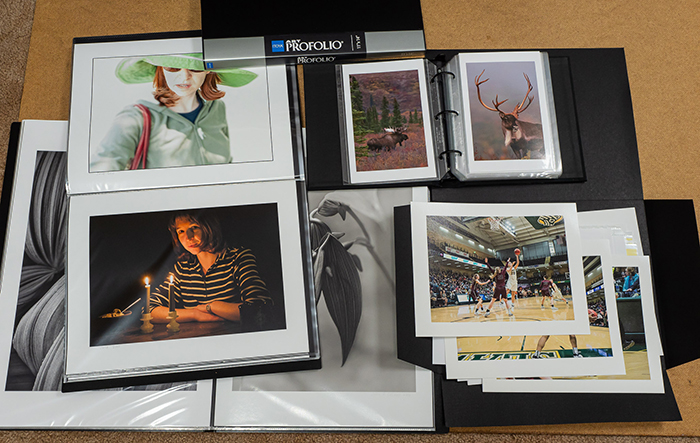Beginning this year, ASONP is requiring all entries selected for alaskaWILD-2023 to be printed on metal. This is not too surprising since metal has become popular, and for some, the preferred medium for displaying photography. In case you don’t know, producing a metal print requires making an intermediate print on paper using special dye-sublimation paper and inks, and then placing the paper print face down on a substrate, in this case on a pre-treated metal sheet which is generally 0.5, 0.7 or 1.1mm thick. This paper-metal combination is then placed in a heated press to infuse the inks onto the metal sheet. The result is typically a vivid image with great colors and contrast and one that is waterproof, durable, and usually displayed without any framing.
Regardless of this popularity and ease of displaying metal prints (and setting aside any cost differences which tend to favor paper prints), there is a case that can be made for paper prints, especially for those of us who are already printing our own work. Ink jet printers, inks, and papers have all improved immensely and produce beautiful color and black and white prints that were not possible a few years ago. Furthermore, there is satisfaction in the hands-on process of turning a virtual image into a tangible print, that can be seen, felt, admired, and shared with others. There is a vast array of different papers that are available providing a wide variety in surface gloss, texture, color, and thickness (weight) from which to choose. These differences allow us to pick the paper that best complements the image to be printed and the feel of the print provides reassurance that the right paper is being used to make a print of the intended quality. Throughout the printing process, the photographer has complete control, and in my opinion, the printing process is the final step in the creative process. I often carry a test print around the house and evaluate it in various types of light and at various viewing distances before finalizing my decision on paper type and on final adjustments to tint and brightness.
Although I have much to learn about the dye-sublimation process, it appears there are several variables that must be carefully controlled by the printer to produce an image that will match the digital file. It is not clear whether the same color profiles used in the digital file or paper printing are applicable in the dye-sub process, plus the dye-sub inks used infuse at different temperatures which complicates the timing (and temperature?) of the heating process. My understanding is that metal prints are limited to either a glossy surface or a satin surface.

A variety of print storage solutions.
One of my goals is to make legacy prints of my favorite images and/or important family pictures for sharing now or passing on to the next generation rather than relying on virtual images. My current printing process allows me to easily work on this goal using paper which can be stored in boxes or portfolio binders without taking up too much room. The included image shows an example of the variety of storage systems that can be used. There are more than a hundred images stored in those various binders and folios. Clearly, not much storage space is required. Hundreds or even thousands of prints could be stored this way but would be much more difficult (and costly) if using metal prints.
Another advantage of paper prints is the ability to easily cycle prints from being in storage to being displayed by using existing frames and mattes. Using standard sizes of paper, mattes, and frames makes it easy to use existing frames and mattes without incurring new costs. The archival properties of silver prints are well established and the current archival inks and papers available for ink jet printing are proving to be very good as well. From my limited research, it appears that archival testing of metal prints is ongoing, but the longevity is still being evaluated. However, the materials being used are thought to be safe and stable for long term use.
Finally, there is a difference between the way metal prints and paper prints look when displayed. As mentioned earlier, metal prints are typically displayed without any framing, yielding a “clean”, and you might say, modern “look”. Paper prints are usually matted and framed giving them a traditional and, in my opinion, a more formal, finished, and appealing look. But each person is free to choose which system is best for their purposes and taste. It is wonderful that we have such good choices for keeping and displaying our photographic art.
By John R DeLapp


2 thoughts on “A Case for Paper Prints”
Great article John! There are definitely pros and cons to all printing techniques (including the extended discussion of printing vs. digital displays). Like you, I enjoy paper prints, especially with the purposes discussed.
Good luck with your 2023 alaskaWILD entries!
Very good commentary, John. If there is one thing I’ve learned from the artistic community is that there are as many tastes as there artists and consumers. The one constant is that everyone wants quality in both the image and final print. Quality comes with skill.
I admire those of you that really know your printing and what I have seen of your final work is nothing short of stunning.
I on the otherhand, am trying to declutter my life. The only things I have in hard prints are images accepted for shows and those often are trashed after the shows are over. I do try to reuse frames where possible. If I were trying to sell images, things might be different.
In the meantime, I will continue to be in awe of the great work that those of you do with your printers.
Comments are closed.